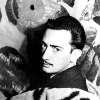Surrealism
Discover art for sale. Buy and sell Surrealist prints & editions online. Surrealism was a ground-breaking art movement that explored the inner workings of the mind by combining the naturalistic with abstract representation.
Art for sale
Movement Overview
Surrealism was a 20th century literary, philosophical and artistic movement that developed in Europe in the aftermath of World War I. Surrealist artists such as René Magritte, Salvador Dalí and Max Ernst developed a range of techniques to help them explore the workings of the mind and the unconscious through art. The Surrealists were proponents of the irrational and the depiction of the illogical or nonsensical in their artworks. This ground-breaking art movement was known for being revolutionary in both a political and artistic sense and had a strong influence on the development of movements in the later half of the 20th century, notably Postmodernism.
Surrealism can be traced back to 1920s Europe in the aftermath of World War I. The movement was influenced by the Dada movement of the 1910s which believed that excessive rational thought and bourgeois values were the cause of the war. The Dadaists argued that culture should rebel against the rational at all costs. The term ‘surrealism’ was first coined by French poet, Guillaume Apollinaire in 1917, however the movement was officially established in October 1924 when French poet and writer, André Breton published the Surrealist Manifesto.
Marked by a disdain for established artistic tradition, the Surrealists aimed to revolutionise human experience, freeing people from false rationality and restrictive structures. The work of Sigmund Freud’s psychoanalytic theory was pivotal in the development of surrealism. Freud’s teaching pushed Surrealist artists to channel their unconscious through art to uncover their inner thoughts and desires, which could also result in unlocking their raw creativity and imagination. The movement was also closely associated with political causes such as communism and anarchism.
The nucleus of the movement was in Paris, France, however from the 1920s onwards, the values and practices of Surrealism spread across the globe, having a tremendous impact on visual arts, literature, film and music.
The place of the visual arts in the Surrealist movement was contested at first. Breton was concerned that the visual arts were less malleable and open to chance and automatism than other mediums of communication, such as literature and poetry. Nevertheless, as more and more artists, such as André Masson, Man Ray, Paul Klee and Joan Miró, became involved with the movement, employing novel techniques such as frottage, grattage and decalcomania, it became accepted that the visual arts belonged to the movement. The role of the visual arts for the Surrealist movement was affirmed with the first Surrealist exhibition, ‘La Peinture Surrealiste’, held at Galerie Pierre in Paris in 1925. This was followed by an exhibition by Man Ray at Galerie Surréaliste in 1926, and in 1928, Breton published a book, Surrealism and Painting, solidifying the incorporation of painting into the movement.
In the Surrealist manifesto, Breton states that the aim of Surrealism is to ‘resolve the previously contradictory conditions of dream and reality into an absolute reality, a super-reality, or a surreality’. More broadly, the aim of Surrealism was to liberate the mind and allow the unconscious to express itself. Surrealist artists strove to bypass logic and rationality, meaning that Surrealist art tends to be full of surprises and marked by unexpected juxtapositions.
Formally, Surrealism was not limited to any specific medium or stylistic rules. This is why the Surrealist movement is considered to be such a revolutionary movement as it spanned all creative disciplines, defying codification.
A key element of Surrealist art is absurd imagery that can be both playful and menacing at the same time. Contradiction lies at the heart of Surrealism where objects are often stripped of their original significance to create compelling images that go beyond logic and reason. René Magritte’s renowned painting, The Treachery of Images from 1929, captures this. In the painting, Magritte depicts an image of a pipe, below it, the artist writes ‘Ceci n’est pas une pipe’ (French for ‘this is not a pipe’).
Along with Magritte, Salvador Dalí is another notable Surrealist artist. Dalí joined the Surrealist movement in 1929 and is remembered for his iconic melting clocks, as seen in The Persistence of Memory, 1931. The artist is also renowned for his floating eyes and anthropomorphic clouds and rocks. As well as paintings, Dalí also produced sculptures, such as his amusing Lobster Telephone, 1938, in which the artist places a lobster comically on top of a classic, black telephone.
Mexican artist Frida Khalo was hailed one of the most influential women in the surrealist movement, despite never identifying with the Surrealist label herself. The Wounded Deer (1946) is one of the artist’s iconic self-portraits which incorporates motifs from Mexican culture to imbue the work with a mythical and surreal feel.
Other noteworthy surrealist artists include Max Ernst, Joan Miró and André Masson. The three artists shared a studio together in Paris in the 1920s, inspiring one another with their creative forays.
An important aspect of Surrealism is that it combines the depictive, the abstract, and the psychological in order to represent the alienation many people felt in the modern period that was marked by dramatic developments in mechanised warfare, travel and industry.
Surrealist artists used various techniques to provide inspiration and free the imagination from the constraints of logic, consciousness and rationality.
In 1925, Ernst invented a graphic art technique, ‘frottage’. This involved taking pencil rubbings from an uneven surface to form the basis of a work of art. He also created a technique called ‘grattage’, in which paint is scraped across canvas to reveal the imprints of the objects beneath. This technique can be seen in his painting Forest and Dove, 1927. Another technique Ernst and other surrealists experimented with was decalcomania, a blotting process in which paint is squeezed between two surfaces to create a mirror image.
One of the most iconic techniques employed by the Surrealists was automatic drawing. Masson was an advocate of this technique which involved producing a drawing with no preconceived subject or composition in mind, free from any conscious control.
Surrealism has permeated the work of a number of artists through the late 20th century until today, including Marc Chagall and Lucian Freud. The movement had a profound impact on the development of Postmodernism and many of the themes and techniques identified as being ‘Postmodern’ resonate strongly with Surrealism.
While the histories of Surrealism tend to focus on Paris in the 1920s, more research today is being done into the global reach of the Surrealist movement. The Tate Modern’s exhibition, ‘Surrealism Beyond Borders’ unveils how artists around the world were inspired and united by Surrealism and how the movement was not limited to Europe and the US, but made a profound impact in cities like Buenos Aires, Cairo, Lisbon, Prague, Seoul, and Tokyo.
Due to its rich and dynamic history, Surrealist art continues to be highly sought after in today’s art market. In 2021, the 20th edition of The Art of the Surreal Evening Sale at Christie's auction house achieved £48,426,000 with a sell-through rate of 90%. Works by Magritte sold for sums ranging from £5-8 million which captures the tremendous buzz that surrounds these works. Surrealism is a niche and highly lucrative market and the range of styles and artists makes it all the more dynamic and exciting.
We connect buyers and sellers of original contemporary and modern prints, facilitating discreet, independent, investment led private sales. Fixed, clear and mutually agreed upon between both parties - simple, safe and secure.
MyArtBroker, 55-56 Russell Square, London WC1B 4HP (by appointment only)
875 Washington St, New York, NY 10014, United States (by appointment only)
- © 2025 MyArtBroker. All rights reserved.
- Privacy Policy
- Cookie policy
- Website terms of use
- Terms and conditions






